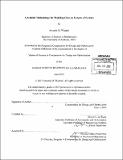| dc.contributor.advisor | Olivier L. de Weck. | en_US |
| dc.contributor.author | Wachtel, Amanda M. (Amanda Marie) | en_US |
| dc.contributor.other | Massachusetts Institute of Technology. Computation for Design and Optimization Program. | en_US |
| dc.date.accessioned | 2013-11-18T19:20:35Z | |
| dc.date.available | 2013-11-18T19:20:35Z | |
| dc.date.copyright | 2013 | en_US |
| dc.date.issued | 2013 | en_US |
| dc.identifier.uri | http://hdl.handle.net/1721.1/82418 | |
| dc.description | Thesis (S.M.)--Massachusetts Institute of Technology, Computation for Design and Optimization Program, 2013. | en_US |
| dc.description | Cataloged from PDF version of thesis. | en_US |
| dc.description | Includes bibliographical references (p. 144-146). | en_US |
| dc.description.abstract | As cities evolve in size and complexity, their component systems become more interconnected. Comprehensive modeling and simulation is needed to capture interactions and correctly assess the impact of changes. This thesis presents a methodology for modeling cities from a systems of systems perspective. The framework supplies general modeling guidelines and key steps. Also addressed are the importance of stakeholder interactions, creating the model structure, using smart city sensor data, and applying the methodology to larger, traditional cities. As an initial step, four city modeling including CityNet, CityOne, Sim City 4, and SoSAT software programs were evaluated from both a user and mathematical perspective. From the assessments, a list was developed of features critical to successful city modeling software including visualization, a streamlined user interface, accurate mathematics, the ability to specify systems and attributes, and the ability to model interconnections between systems. SoSAT was selected as the modeling tool for the case study, which involved modeling the Army's Base Camp Integration Laboratory. A model of the camp's baseline configuration was built and the camp was simulated for 30 days with results recorded at one hour intervals. 100 trials were run with averaged results presented by time intervals and for the total simulation time. Results were presented at all levels of structural aggregation. Two sensitivity analyses were conducted to analyze the impact of maintenance personnel and the frequency of potable water deliveries. Adding or subtracting a maintenance person impacted the availability of the generator systems that were being serviced, in turn impacting the performance of the micro grid. Extending the time between deliveries by 24 and 48 hours revealed two systems experienced resource depletions. Lastly, two technology insertions cases were conducted to assess the impact of adding a laundry water reuse system (LWRS) and a solar powered hot water heater (SHWH). The LWRS provided 70% of the laundry system's water needs, significantly reducing dependency upon deliveries. The SHWH was expected to decrease electricity consumption and increase fuel consumption. However, the reduction in energy demand meant fewer generators were needed to power the micro grid and both electricity and fuel consumption decreased. | en_US |
| dc.description.statementofresponsibility | by Amanda M. Wachtel. | en_US |
| dc.format.extent | 146 p. | en_US |
| dc.language.iso | eng | en_US |
| dc.publisher | Massachusetts Institute of Technology | en_US |
| dc.rights | M.I.T. theses are protected by
copyright. They may be viewed from this source for any purpose, but
reproduction or distribution in any format is prohibited without written
permission. See provided URL for inquiries about permission. | en_US |
| dc.rights.uri | http://dspace.mit.edu/handle/1721.1/7582 | en_US |
| dc.subject | Computation for Design and Optimization Program. | en_US |
| dc.title | A scalable methodology for modeling cities as systems of systems | en_US |
| dc.type | Thesis | en_US |
| dc.description.degree | S.M. | en_US |
| dc.contributor.department | Massachusetts Institute of Technology. Computation for Design and Optimization Program | |
| dc.identifier.oclc | 862817717 | en_US |
